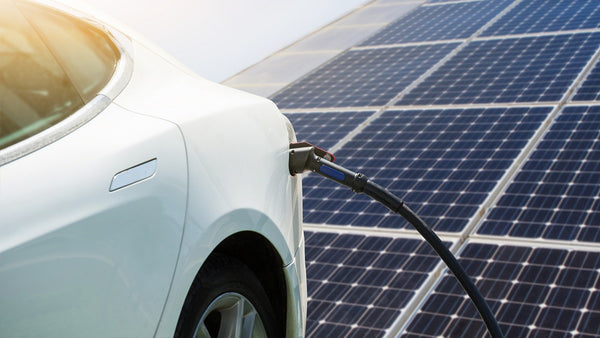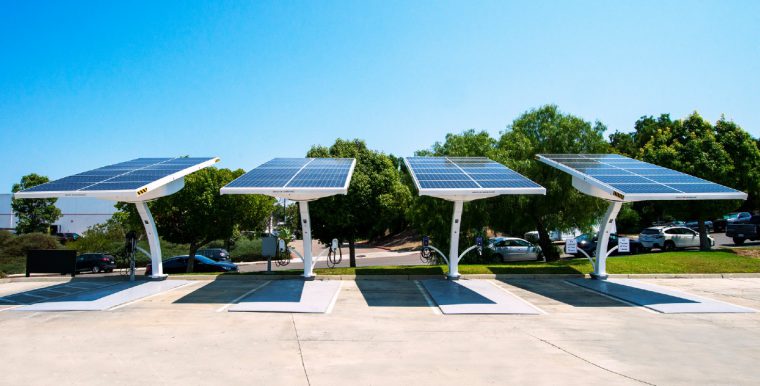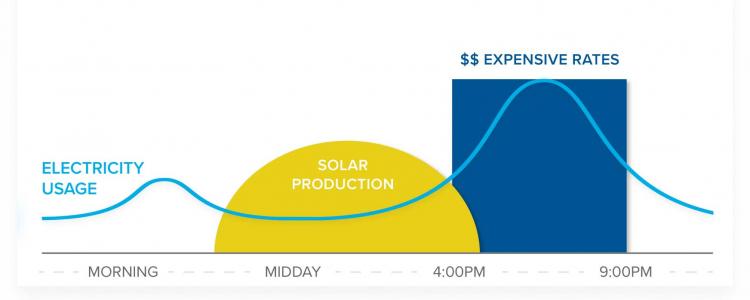Solar Power Blog

Solar Energy & Electric Vehicles - Summer 2022
Whether you’re watching television during a commercial break or are out on the road somewhere this summer, the presence of electric vehicles in the United States is at an all-time high and certainly more visible than ever.
Of course at Solar Us Shop, we couldn’t be more excited as, when in use, electric vehicles produce less overall emissions than traditional combustion chamber engines. With a greener future ahead, it is actually a bit shocking when you realize that cars are now being powered by the sun, via photovoltaic (PV) solar energy systems, all around the world.
Last summer we answered the question, “Can solar panels charge EVs?” to showcase exactly how small PV systems can power personal vehicles.
This summer, as PV capacity and electric vehicle adoption volume continue to accelerate both nationwide and globally despite supply chain shortages, let’s take a closer look at the clean energy transportation revolution and show how solar plays an important, supporting role.
Why are people switching to EVs?
Other than the fact that gas prices just hit an all-time high, the switch to electric vehicles has been driven by both financially and eco-conscious consumers since the turn of the millennium. Accelerated by tax incentives, government grants, and claims that they are just flat-out fun to drive, EVs are here to stay for both personal and commercial transportation.

Today there are hundreds of alternative fuel vehicle makes and models on the market today, divided between hybrids, plug-in hybrids, and purely electric cars and trucks. As both the electric motor and energy storage technology continues to advance, battery-based electric vehicles (BEVs) are now the fastest growing and most energy-efficient EVs available today.
The United States of Electrification
Supporting infrastructure is one of the main reasons that electric vehicle adoption has been limited so far, but there are many areas throughout the country in which public charging stations, as well as EV-friendly policies and incentives, have helped the growth of clean energy transportation.
While the majority of EV owners charge their vehicles at home or work, those that are living outside of a network of charging stations have very few additional options to refuel their batteries when there are no public power ports available. Thankfully, modern EVs continue to improve their overall driving range and many private and public companies are racing to build a national network of EV charging stations.
To paint a broader picture, here is a graph that shows total electric vehicle registrations by state:

Image source: https://afdc.energy.gov/data/10962
In contrast, here is a map that displays the amount of solar energy generation per capita across the United States of America.

Image source: https://ilsr.org/the-states-of-distributed-solar/
As you can see, in both datasets, California leads the way in electric vehicle registrations and distributed solar generation. This is no surprise, as California is the first state in the country to pass a bill that guarantees solar energy installations on new construction projects.
Plus, California hopes to “have five million zero-emission vehicles (ZEVs) on the road by 2030 and 250,000 electric vehicle charging stations by 2025,” to meet air quality and climate change targets.
In contrast, Washington is within the top 5 EV registration states, without a significant amount of solar generation per capita. Due to geolocation considerations, states like Washington may be able to better support vehicular electrification with other renewable resources (besides solar) such as hydropower and wind energy.
Right in the middle, there are many states in which EV adoption and solar energy production are rising together such as Colorado, New York, and Massachusetts. Likewise, states such as Texas (now the HQ for Tesla, Inc.) and Florida (whose solar net metering laws were almost dialed back) are quickly stepping up both their solar and EV volumes.
Save the Most with Solar
Across the United States, both home and business owners have the unique opportunity to combine personal solar energy production with electric vehicle charging. Distributed solar energy system ownership allows consumers to generate their own power and use it however they choose, which can lead to convenient and cheap BEV fueling.
With a battery-based solar-energy system, EV owners have the most control over their own energy production and usage and can power their vehicles in specific instances to mitigate higher-tiered energy rates or time-of-use billing structures enforced by local utilities.

So whether for regularly powering your vehicle or storing electricity in a battery for emergency charging, solar energy systems offer renewable, emission-free electricity generation anywhere the sun shines. Therefore, if you’ve decided to purchase an EV for financial or environmental reasons, a personal green energy power plant is the perfect complement to achieve your goals with zero-emission, zero-cost daily electricity production.
Conclusion
While not every area in the country is ideal for efficient solar power production, electric vehicle owners have a great opportunity to combine renewable energy and EV charging. By doing so, EV owners can minimize their energy costs and environmental impact with their own solar-powered vehicles.
Today, many of the countries' top solar companies are including EV charging systems as a seamless add-on to a residential PV installation. Even more so, the world's top engineers are now taking “solar-powered cars” quite literally, with many new and exciting vehicles that utilize solar roofs for continuous energy generation and use.
All in all, there has never been a more exciting time to watch the future of transportation unfold.
For more information, feel free to check out all of our electric vehicle articles or jump to our Solar Energy Frequently Asked Questions.

